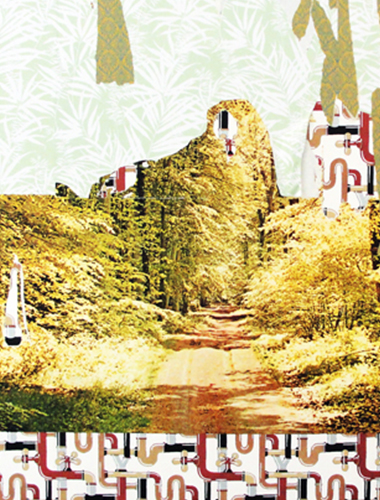
Patrizio Di Massimo
Inci Eviner
Lars Laumann
Ursula Mayer
Charly Nijensohn
Nova Paul
Aïda Ruilova
Luisa Rabbia
Gallery 3
Gallery 4 and Contemporary Space
Alejandra Seeber
Galleries 5 and 6
"Unseen voices"
Alejandro Cesarco
Jorge Méndez Blake
Contemporary Space
Sintonías
Mirtha Dermisache
Elba Bairon
Alejandro Cesarco
Esteban Pastorino
Patrizio Di Massimo
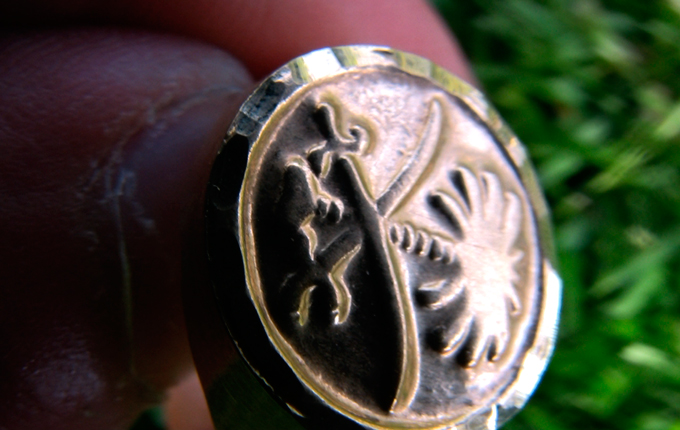
Oae, 2009 (13’17’’). Courtesy of the artist. Presented by Galleria d´Arte Moderna e Contemporanea di Bergamo, GAMeC, Bergamo, Italia (www.gamec.it)
The video piece by Patrizio Di Massimo entitled
Oae is the account of a real and metaphorical journey into Italy’s colonialist past in Libya and in what remains, today, of those dark years of Italian dominion.
The 13-minute film made by the artist along the streets of today’s Tripoli, during a trip taken in 2008, combines archival material and pieces from cinematographic fiction inspired by fascist rule in Libya (from 1911 to 1940), in a constant overlapping of past and present, individual experience and collective denial. As a travel journal, Oae is an account that is full of ellipses and ambiguity, as if the real protagonist were not the memory of the colonialist past as much as its negation by both sides. By combining bits of the everyday with fragments from the film Lion of the Desert of 1981 (a film censored in Italy by Andreotti’s regime because it was “prejudicial to the honor of Italy’s armed forces”) Oae stages an absence and a taboo, something that the artist himself defines as “a part of Italy outside Italy. The persistence of this identity that is hard to resist and has a hard time existing.” As the camera scours the streets of Tripoli in search of those sculptures of Italian propaganda that were destroyed, or buildings representing Fascist Rationalism now partly repainted green, an intermingling of different foreign languages mediated in English provides an audio commentary for the images, as if it were the symphonic orchestration of a permanent cultural disparity and permanent reciprocal misunderstanding.
The work’s title comes from the ancient Phoenician name Oae. In its ghostlike and suppressed existence, the history of Italian colonialism in Libya is re-evoked by the ruins of Leptis Magna at the theater of Sabratha, by the golden ring – symbol of Libyan resistance that appears at the beginning of the video, and by the ride along the coastal highway by car that ends the piece.
Patrizio Di Massimo also describes his motivation for creating Oae: “While maintaining an enormous respect for all the victims of colonization, both Libyan (mujaheddin and civil) and Italian (soldiers), I tried to create an autonomous reality that didn’t use history in an opportunistic manner—which Italian politicians tend to do today when speaking about the guilt of our compatriots in Libya—nor in a revisionist manner. Because of this my presence is not the main subject of the video. The main subjects are the lack of understanding, the languages that mix, the raw and poetic images that are both stereotyped and vertical.”
Alessandro Rabottini
---
Inci Eviner
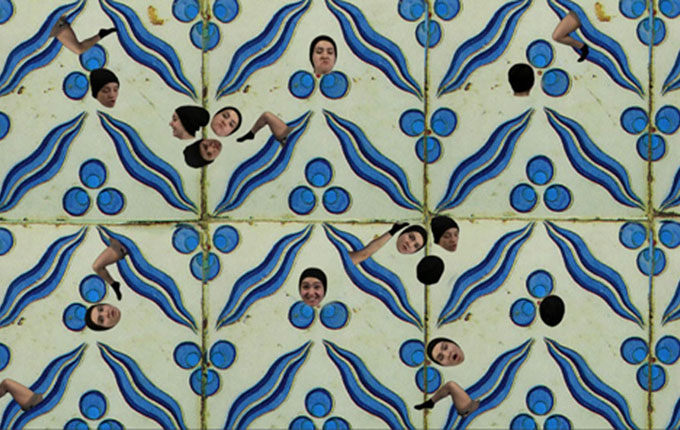
New Citizen, 2009 (Video on an LCD screen, 3 minute loop). Courtesy of the artist. Presented by The Institute for the Readjustment of Clocks, organized by Istanbul Modern, Istnabul, Turkey (www.saatleriayarlamaenstitusu.com)
In the postcards that I collected from Paris and Istanbul, I gave the possibility of existence to the girls captured in the patterns and they told their own stories.
To insert New Citizen into Europe with its new historical associations, allowed for an expression that pushes the limits of tradition of European representation. As a way to transcend representation, I borrowed strategic sources from wall papers and Turkish tiles, which became tools of deconstruction that will work from within the patterns. Colonial images, which have been relatively excluded from art history –monkeys running around in joy, Chinese women involved in a tea ceremony– found a place for themselves, multiplied infinitely with the surfaces they occupy and became part of collective memory with the atmosphere they have created. This ornamental transformation of the “Other” is the result of a decorative reconciliation. Without realizing, they affect our gaze and transform it. Contrary to intentional gaze, we don’t look at wallpapers; they surround us as objects of involuntary unintentional gaze... Wallpapers -besides hosting heavy oil paintings and reflecting the house owner’s elite taste- and tiles are a realm of uncanny images that are accumulating towards the unconscious beyond a mystical atmosphere.
I have performed interventions on the postcard, which I found at a museum foyer in Paris, to reveal the desire arrested in the images of the Chinese woman and the boy. The Chinese woman is surprised by the sudden appearance of her phallus and the boy becomes a narcissist against Europe’s Islamophobia; covered and caressing himself. Knowledge that is colonial, oriental or produced through any other ideological discourse does not only create the other but also transforms it into an image. To save ‘difference’ that cannot be rehabilitated or tamed from these discourses, I bestowed them with their own gestures.
The Çintemani pattern, which is often used as a touristic image of Turkey, has been removed from its own surface and circulates as a cultural representation. The violence inherent in this pattern, which is a populist reflection of cultural consumption, released the possibility of resistance in the dizzying and angry actions of the girls. To create a space of existence for the New Citizen, I freed it from the imposed definitions and from the world of narrow meanings of all ideological gazes. To reflect on the cultural differences that are suppressed and left outside of the political borders of Europe, hiding in the innocent patterns of the ornament, I entitled them to the right to move. These timeless frozen images are freed with the possibilities of video technology.
Inci Eviner and Kutlug Altman
---
Inci Eviner was born in Polatlı (Turkey) in 1956, lives and works in Istanbul, Turkey. Holds a Bachelors and Masters degree from the State Academy of Fine Arts in Istanbul. Conducted several artists residencies on several prestigious institutions including the Rockefeller Foundation in Bellagio (2000); The International Studio and Curatorial Program in New York (2004), Group Program LEUBE for artists in residence in Salzburgo (2005), and the Cité Internationale des Arts in Paris (2008). Has exhibited her work at the Nev Gallery (Istanbul), Monique Goldstrom Gallery (New York), Mizuma (Tokyo), and the Deutche Museum in Berlin. Participated in the Biennales of Shangai, Istanbul and Venice.
Lars Laumann
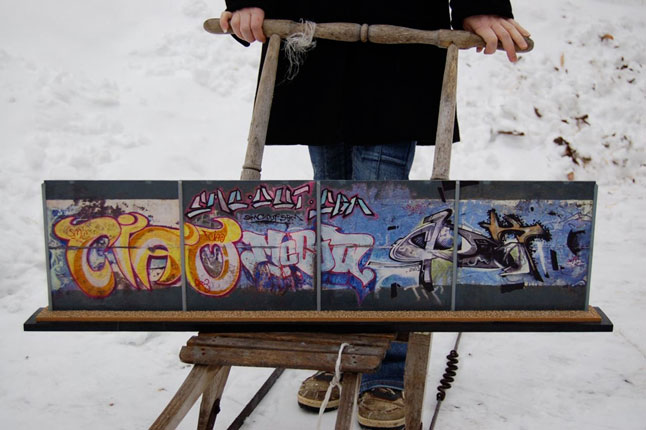
Berlinmuren, 2008 (23’56’’). Courtesy of Maureen Paley. Presented by Henie Onstad Kunstsenter, Hovikodden, Norway (www.hok.no)
Unless you have turned your back on the world, you probably find yourself surrounded by a global culture industry in which art is a commodity like any other and the internet is omnipresent. One can heave a sigh over the system this entails or one can fall in love with the possibilities of such freely exchanged information. The Norwegian video artist Lars Laumann (b. 1975) has done the latter.
In several of his video works, Laumann draws his inspiration from the internet. From chat rooms, fan culture or obscure homepages, where the information on offer is uncensored and passionate. Almost to the point of obsession. One of Laumann’s earlier films, Morrissey Fortelling the Death of Diana (2006) is about the conspiracy theories that circulate on the internet. More specifically, its theme is the unanswerable question of how, on the album The Queen is Dead by the group The Smiths, lead singer Morrissey managed to foresee the death of Princess Diana eleven years before it happened. How was this possible? The work is a video montage composed of picture material from existing films. In a voice-over that accompanies us through the entire film, the links between Morrissey’s song, video and cover material on the one hand and Diana’s death on the other are meticulously presented. It is intense, absurd and claustrophobic. Laumann’s latest film Shut up Child! This ain’t Bingo (2009) also focuses on a story of the more obscure kind, even if in this case reality remains somewhat closer to hand. We are introduced to Laumann’s colleague Kjersti Andvig, herself a Norwegian artist, and learn about the relationship she built up with death-row convict Carlton A. Turner, who was executed in Texas on 10 July 2008. By means of interviews we are drawn into the love affair, the desperation and – ultimately – the religious and supernatural fantasies to which Andvig turned, in a situation of sheer urgency during the days just before the execution. But we are also drawn into the bizarre and self-destructive aspect of Andvig’s relationship to Turner, something that makes Laumann’s use of his material all the more absorbing. Shut up Child! is neither a political statement about the death penalty nor a love story pure and simple; rather, it is first and foremost a story about obsession and the convictions, or mania, if you prefer, that go with it, reinforced by Andvig’s growing belief in Turner’s rebirth. “I had a powerful sense of really, really wanting Carlton to love me as I left the prison,” Andvig says at one point in the film, “but I don’t know whether this was because I was in need of love or he needed someone to love.”The work Henie Onstad has chosen for the second Art in the Auditorium series, Berlinmuren (The Berlin Wall), 2008, was greeted with deserved acclaim at last year’s Berlin Biennial. Among Laumann’s archive of curious tales from the margins of the cultural world, this is probably the most curious. The film is about the relationship between the Swede Eija-Riitta Berliner-Mauer and the Berlin Wall. In other words, not quite your standard love story. Laumann came across the story on Berliner-Mauer’s own website, where Berliner-Mauer describes how she was first attracted to the wall due to her object sexuality, how she married “him” in 1979, and how – quite understandably – she experienced “his” fall in 1989 as especially traumatic. “We have been together now for many years, spiritually if not physically. Like every married couple, we have our ups and downs. We even made it through the terrible disaster of November 9, 1989, when my husband was subjected to frenzied attacks by a mob. We may not have a conventional marriage, but neither of us cares much for conventions. Ours is a story of two beings in love, our souls entwined for all eternity,” she says. In Laumann’s film, Berliner-Mauer describes how she feels attracted emotionally and sexually by objects. Objects, she claims, have feelings, intelligence, and can communicate in much the same way as people and animals. For large parts of the film, Laumann allows Berliner-Mauer to explain her story and orientation in frank and sober terms. In this way he exposes us to one of the internet’s more marginal underground stories, which for a brief moment mainstream culture has made its own.
Whether it is a matter of a singer predicting the death of Princess Diana, the relationship between an artist and someone condemned to death, or a Swedish woman married to the Berlin Wall, Laumann has an eye for weird stories and a talent for telling them. The artist uncovers the eccentric, what lies beyond the pale, while at the same time allowing us as viewers to be swept along by his sometimes nerdish fascination for these phenomena. With video as his ostensibly preferred medium, in his more recent films Laumann creates explorative documentaries, partly by presenting his characters as interview subjects. He probes the boundaries between the private (the stories of Berliner-Mauer and Andvig are unusually personal) and the documentary investigation thereof. At the same time Laumann keeps the gaze of his camera at a distance: The result is never compromising.
In Shut up Child! Andvig refers to the concept of “suspension of disbelief”. The world of fiction presupposes that we believe in premises that we would not accept in reality. In the genres of fantasy and science fiction in particular, things happen that we would not believe if they appeared in a newspaper or were presented as fact. In order to draw pleasure from such narratives, the audience has to engage in the “suspension of disbelief”. More or less consciously we ignore what we do not believe and accept the premises for the story as true for as long as it lasts. Provided it insists on its truthfulness and does not push the boundaries too far, of course. As a committed storyteller, Laumann dives into the more obscure human passions and re-emerges carrying peculiar tales about one aspect of the world – here and now. The fact that we also believe what Laumann´s films tells us is a credit to his method of communication and its inherent plausibility.
Caroline Ungelstad
---
Lars Laumann was born in Bronnoysund (Norway) in 1975, lives and works in his country of origin. Studied in the State Academy of Norway in Oslo and the Film and Art School from North Norway in Kabelvåg. He held solo exhibtions at the Maureen Paley Gallery (2008,2009, London). His videos were shown at White Columns (New York), Galuzin Gallery (Oslo), Le Commissariat (Paris). He participated in several group shows such as As Long As It Lasts at the Marian Goodman Gallery (2009, Nueva York); Back to the Future atCOMA (Berlin, 2009); Jours lounges et nuit lumineuses at Bergen Kunsthall (Bergen); and participated in the Berlin Biennale in 2008.
Ursula Mayer
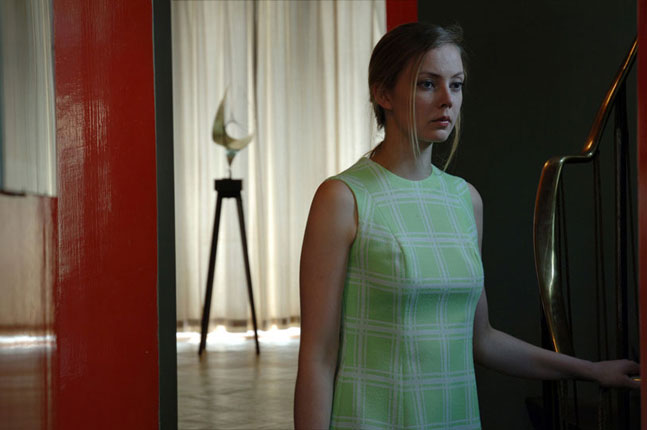
Interiors, 2006 (3’10’’). Cortesía de la artista y de Monitor Gallery, Roma. Presentada por Whitechapel Gallery Londres, Inglaterra (www.whitechapel.org)
La artista austríaca Ursula Mayer crea coreografías con protagonistas femeninas, contra un fondo de arquitectura icónica y claves tomadas de la historia cultural. Entre la monocromía y el color, el movimiento erótico y la pose estatuaria, las películas de Mayer proponen una sutil conjugación de espacio y tiempo.
Interiors (Interiores) está ambientada en la casa del arquitecto y émigré húngaro Erno Goldfinger y su esposa, heredera y artista, Ursula Blackwell. Su famoso departamento modernista en Hampstead, Londres —que alberga esculturas de Barbara Hepworth y Max Ernst—, es escenificado por dos mujeres que, como camaleones, toman el aspecto de distintas obras de la vanguardia cinematográfica y artística del siglo xx. Las protagonistas jamás se encuentran en su fluir continuo, bajan y suben constantemente por una escalera de caracol y ocupan las habitaciones de la casa a través del movimiento y el tacto. El punto central donde todo converge es una escultura giratoria de Barbara Hepworth, obra que deviene en faro que orienta la comunicación muda entre dos generaciones.
Candy Stobbs y Andrea Tarsia
---
Ursula Mayer nació en Austria en 1979. Vive y trabaja en Londres. Obtuvo una licenciatura en la Academy of Fine Arts de Viena en 1996 y luego continuó sus estudios en el Royal College of Art de Londres. Sus exhibiciones mas recientes son Nought to Sixty, Institute of Contemporary Arts (Inglaterra) en 2008 y The Crystals of Time, Lentos Museum of Modern Art (Austria) en 2007. Formó parte de varias exhibiciones grupales en reconocidas intituciones internacionales: RCM Art Museum (China), Museum of Modern Art de Viena (Austria) y Ursula Blickle Foundation (Alemania), entre otras. En el 2009 recibió el Federal Ministry Award for Fine Arts en Viena.
Charly Nijensohn
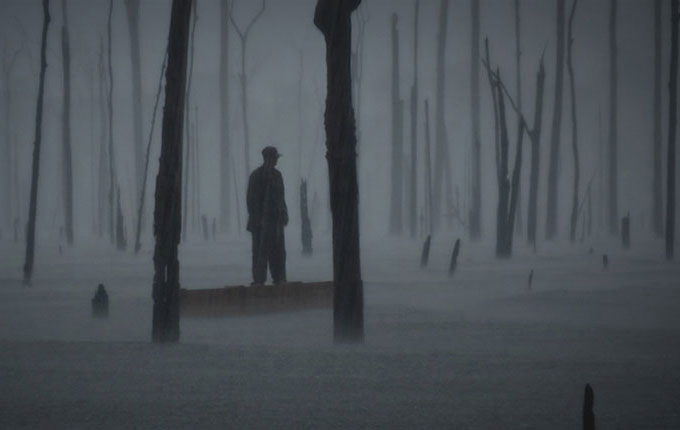
Dead Forest Storm, 2009 (4’48’’). Courtesy of the artist. Presented by Fundación Proa, Buenos Aires, Argentina.
Charly Nijensohn’s videos engage the viewer through their provocative intensity. Even while they are not based on a tangible narrative, and do not suggest one single meaning, their powerful images and handling of sound create a hypnotic impact that makes it impossible to remain indifferent.
The point of departure always tends to be the same: a performative act of a certain duration where an individual is situated in a majestic but menacing natural environment. The relationship between the human figure and the surrounding space establishes a conflict that is both real and existential at the same time. The environment is presented as being hostile, deceptively stable at times and momentarily even lethal, but the main character persists in his endeavor to overcome adversity. We never know why or to what ends this endeavor is undertaken, but we sense a force of necessity, which leads us to identify with him, to feel and resist along with him.
By way of notable efforts toward expressive synthesis, Nijensohn assembles a powerful audiovisual composition that presents the unremitting tension between mankind and nature. Along his semantic horizon line resonance can be found with the concept of the sublime, that complex and contradictory mix of admiration and terror that shakes up and paralyzes the soul. However, as is to be expected, here we are not dealing with a post-modern version of Lyotard or Jameson that translates the annihilating experience of urban contemporary life, but rather a formulation that lies closer to the romantic original fundamental to Kant’s aesthetic. Kant often draws upon examples of nature’s destructive potential to characterize the concept, and from it he derives the type of emotional intensity that manifests itself in the experience of the sublime. Dead Forest (Rain) regains this inheritance, arousing the same sensations of alarm and fascination.
Although it provides scant contextual information, this work draws upon the viewer’s knowledge and the symbolic capacity of its location site. The Amazon river basin is one of humanity’s indispensable natural resources, but it is also among the most unstable and threatened. The transformation of its ecosystem and indiscriminate deforestation have been acknowledged as causes of the climatic changes that affect Earth as a whole. As such, any intervention in this particular site functions as an event with extended reach: the local conflict propagates its echoes in the global imagery of a world aware of its own lack of equilibrium.
On the other hand, this piece extends projections on different metaphoric levels. The omnipresence of water, attacking and at the same time nourishing the central character in the action, forms a fluid, liquid universe in which we can perceive another representation of contemporary life. However, beyond the shadow of a doubt the metaphor that is highlighted with greatest intensity is that of resistance, a recurring image in Charly Nijensohn’s work which takes on eloquent political connotations in the context of Argentina, where to a certain degree it can be translated into the artist’s very existence in an environment that is hostile for non-commercial production, and from which he eventually had to emigrate.It only from this perspective that it is possible to comprehend Nijensohn’s work in all its magnitude. This is because his poetic sense is a sensitive manifestation of an existential aesthetic that is nourished by a crucial circulation around the world. Although the characters in his videos are always alone, society is there as a horizon and persistence is a principle of hope that expands outward by way of vibrations that the work incites in the heart of each and every viewer.
Rodrigo Alonso
---
Charly Nijensohn was born in Buenos Aires (Argentina) in 1966, lives and works in Berlin (Germany). His works have been exhibited among other places in: Biennal of Venice 2003 (Italy), Valencia 2001 (Spain), Modern Museum of Art of New York (US), ARCO 2001, Biennal of the Mercosur 2000 (Brazil), National Museum of Spain Reina Sofia (Spain), Media City Festival (Canada), Armory Show, New York (US), Biennal of Buenos Aires 2000 (Argentina), Interferences (France). He has received several awards from international cultural institutions such as: ArteBa, Konex, Fundación Antorchas, Asociación de Criticos and at the French Festival Interferences.
Nova Paul
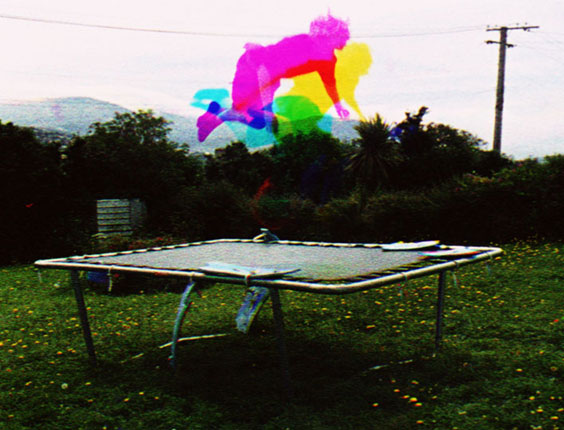
Pink and White Terraces, 2006 (8’33’’). Cortesía del artista. Presentada por City Gallery. Wellington, Nueva Zelanda (www.citygallery.org.nz)
We are who we are
Nova Paul's 16mm film Pink and White Terraces, reflects on the delicate construction of domestic environments and public places in the Tamaki Makaurau and Manukau cityscapes in Aotearoa New Zealand. Using a 'three-colour separation' optical process technique, the film makes visible several moments simultaneously. In red, green and blue layers, colour-coded auras hold records of time like geological accretions. The politics and poetics of these sites gently unfolds as the film moves in and out of phase, as actors and environment focus and fade, and filmic time is made palpable.
Cities are living entities. The density of communal living in urban space necessitates acts of creativity to individualise and shape the environment to make it a home that reflects you, your family and your network of friends. Like water, people find a route through the most complex or oblique channels to lead a self-determined life. The way we decorate our homes, choose to do business or spend our leisure time are all part of this process. Within a city, points of contact with others vary from the most fleeting of encounters to life-long friendships. How are these myriad of networks represented, or made tangible, how do they inform the way our cities look and change? How does the domestic influence the civic?
The film is comprised of a series of static shots where the same place or action has been recorded three times, making tangible that no location is static, that people move through space, and qualities of light and weather change. The film depicts fleeting moments; from barren trees in winter afternoon light, through to a hot summer day on a front porch with friends, washing dishes at night, or getting dressed to go out, shopping at a busy Sunday market, to popping in to the corner shop (which in Aotearoa is known as a dairy).
The title Pink and White Terraces, refers to an area of geothermal architecture which was located on the edges of Lake Rotomahana, near Rotorua in the central part of the North Island of Aotearoa. In the 1880s these eerie, fantastic land forms were a leading tourist attraction – at a time when the notion of ‘tourism’ was intrinsically linked to a fervent drive for European immigration by the new Colonial government. The area of Rotorua and Taupo was already home to the Te Arawa peoples, the Māori iwi (tribe) who had settled the area.
The Terraces were created from the overflow from geysers, rich in siliceous sinter that cascaded down a hill side. White silica deposits accrued, forming large pools and terraces. Similar forms exist within the geothermal areas of Yellowstone National Park, USA and at Pamukkale, Turkey. The White Terraces (Te Tarata - the tattooed rock), the larger of the two configurations, covered three hectares and descended over thirty metres. The Pink Terraces (Otukapuarangi - fountain of the clouded sky) were the best bathing spot and the waters were deemed to have healing properties. On the 10 June 1886 neighbouring Mt Tarawera erupted, decimating the area. Several villages were buried, including the settlement of Te Wairoa, killing over 150 people. A crater over 100m deep encompased the site of the former terraces, creating a new Lake Rotomahana and submerging the terraces forever.
The Pink and White Terraces loom large in the cultural memory of Aotearoa, largely through surviving photographs, prints and painted depictions. They have come to represent great loss: of life, of the settlements that were destroyed, and that of an incredible, errant natural form. It is also worth noting that between 1845 and 1872 a series of brutal armed conflicts between colonial troops and Maori, now known as the ‘Land Wars’, were being waged across the country. While Aotearoa is peppered with active volcanoes and has a tumultuous geothermal character, the land has also seen many battles over land, sovereignty and language, which continue to this day.
The way that the mineral rich geothermal waters were able, to forge a habitat of spectacular form and beauty - both because of and despite their site, is a telling metaphor for the way people create their own sense of place within dense urban settlements. In Paul’s film she concentrates on intimate scenes and modest domestic architecture. The spaces in the film that seem ‘public’ are a mixture of private or commercial space (e.g. the container holding area of the Port of Auckland, Wah Lees Emporium, the Good Morning Dairy) and civic zones where people have freedom of passage, street intersections, city centres like Aotea Square in the CBD of Tamaki Makaurau (Auckland). Predominantly she eschews official landmarks or places deemed to be ‘important’ or of high status, and all sites are treated in the same delicate and perceptive manner, whether a fish shop or a street protest.
The soundtrack by Rachel Shearer uses atmospheric sound recorded during the shoot mixed with a palette of sounds derived from the colour presence on screen, uniting the abstract and the figurative. Pink and White Terraces traces little happenings, things we do without acknowledging them as 'significant', but which speak clearly about who we are individually and collectively.Nova Paul y Heather Galbraith
---
Nova Paul was born in Aotearoa (New Zealand) in 1973. Paul’s film making practice utilises the optical printing process of three colour separation, an early cinematic technique. Her first film to pioneer this was Pink and White Terraces(2006). It has screened at the Telecom 2006 New Zealand International Film Festival and been exhibited in numerous exhibitions including Bandung Institute of Technology Architecture Gallery, Bandung, (2006), Telecom Prospect 2007: New Art New Zealand, City Gallery Wellington, The Physics Room, Christchurch, (2007) Lismore Regional Gallery, Lismore (2007), Project Space, Melbourne (2008).
Solo exhibitions include New Zealand Film Archive (2001, 2008) Gow Langsford Gallery (2007), Ramp Gallery, Hamilton, (2002). Other group exhibitions include Martini Shot: New Artists Show, Artspace, Auckland (2007) and The Buzzing Confusion of Things, St Paul Street Gallery, Auckland (2008).
Aïda Ruilova
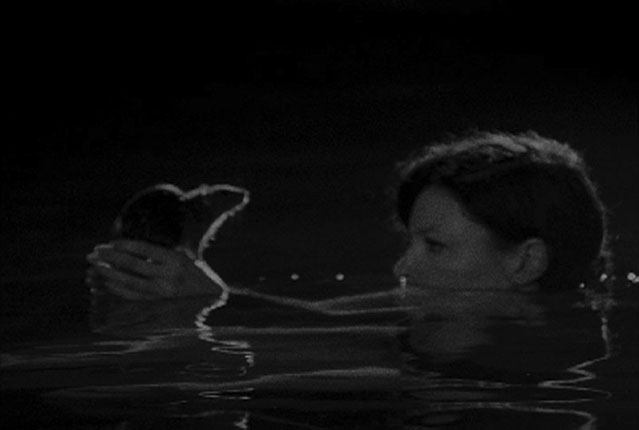
Two-timers, 2008 (2’40’’). Presentado por Ballroom Marfa. Texas, Estados Unidos (www.ballroommarfa.org)
Aida Ruilova was born in 1974 in Wheeling, West Virginia (US), lives and works in New York. Graduated from the University of South Florida (US) with a major in Fine Arts and has a MBA from the Visual Arts School of New York (US). She was part of the residency program for artists at the Hammer Museum, where her work was also exhibited. Her most recent solo exhibitions were in the Kitchen (New York) the Moore Space (Miami); The Center of Curatorial Studies at Bart (Nueva York), Aïda Ruilova: The Singles, 1999–Now co-organized by the Museum of Art of Aspen and The Museum of Contemporary Art in St. Louis. Her work was included on several international exhibitions such as Sympathy for the Devil held in the Museum of Contemporary Art of Chicago (2008); Uncertain States of America in the Museum Astrup Fearnley of Oslo (2005). She also participated in the Whitney Biennale (2004), Berlin Biennale (2006), and Venice Biennale (2003).
Luisa Rabbia
Gallery 3
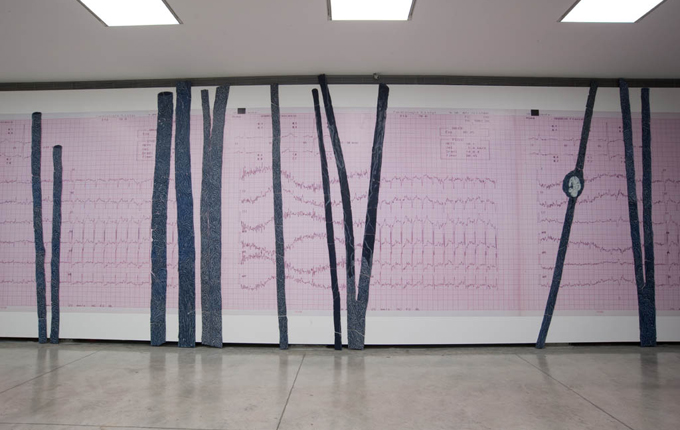
The Following Day, No One Died, 2009
Cortesía de la artist
For her first presentation in Argentina, Italian artist Luisa Rabbia presents two works in Fundación PROA, gallery 3. Curates in collaboration with Beatrice Merz, the exhibition evolves around two central works, consisting of a video and a wall installation,
With traveling as the main theme, the works take us through an intimate, imaginary and surreal journey.
The result is a sort of diary, a narrative that develops through a net of drawings: endless roots, fragments of the artist’s work and clips from her previous videos that are all like blood vessels of a life journey.
This project is a journey in the mid of life, where one day somehow follows the other, between sunrise and sunset; perhaps it’s part of a greater journey that starts with birth and ends with death…” (Luisa Rabbia)
The video Travels with Isabella, Travel Scrapbooks 1883/2008 was conceived during the artist’s residency at The Isabella Stewart Gardner Museum in Boston. Luisa Rabbia was inspired by the photographs collected by Isabella Stewart Gardner (1840-1924), during her journey through China in 1883, to create an entrancing animated trail: a scenario of images from ancient China on which she composes her personal diary made of drawings, video footage from her previous works and works from the museum collection.
In the installation The following day, no one died, placed on one of the large walls of Fundación PROA, the porcelain marks interact with her father’s ECG as if extending the past into the present, to let that distant moment in time live on, the script of life…
A conversation: Beatrice Merz and Luisa Rabbia
Beatrice Merz The exhibition (…) intertwines your world formed of loneliness, psychological insecurity, of memories with images taken from the lives of others. The result is a sort of diary, a narrative consisting of a web of drawings: infinite roots, snapshots of works and pieces of previous videos. All arteries of a path of life…
(…) For you, is drawing a point of departure or arrival?
Luisa Rabbia It is a point of arrival because it seems to collect and embrace all my previous research. It is a starting point, because it is a technique that expands, both in its meanings and in the different media it involves. But it is also a point of passage that records everything that appears in a span of time. Drawing is like a script that translates words into images, but very often it is like writing without knowing exactly what you're talking about because drawing is born in an instinctive manner, in a more or less extended period of time.
(…)
BM You made the video Travels with Isabella. Travel Scrapbooks 1883-2008 during your residence at the Isabella Stewart Gardner Museum in Boston. Inspired by the photo albums of the collector, Isabella Stewart Gardner, which she put together during her travels to China in 1883, you have produced a fascinating animated journey in which images of ancient China become the backdrop for your diary made up of drawings, excerpts of other videos and works from the museum collection. The result is a fantastic narrative between the contemporary imagination of the artist and of historic China, between past and present, between the intertwined lives of two women. (…) What value has time and place in your work? What does the combination of time and geographically distant mean?
LR In Travels with Isabella, different times and places come together in a journey in memory that runs without any chronological order. I think this is the way in which we remember: although we make a note of dates and times, closing one’s eyes, past events come together, mingle, change order. What remains is their taste, indistinct. It almost seems that, once passed, things become a whole. That whole which is then the result of our present because we are made of everything that happened before.
(…) Albert Einstein said: "People like us, who believe in physics, know that the distinction, between past, present and future is only a stubbornly persistent illusion". I encountered this phrase when I was totally immersed in The following Day, No One Died and found a dialogue within myself; I was living it, not just theorising it.
It fascinates me to think that through drawing, line by line, register those little seconds that seem to exist, but are those that make up the hours, days, years. I am interested in the connection between things, look in time, work places, thoughts, human actions.
It fascinates me to think that through drawing, line by line, I register those little seconds that seem inexistent, but which make up the hours, days, years. I am interested in the connection between things, in searching for these in time, in places, in thoughts, in human actions.
(…)
BM The succession of pictures in the video from right to left without a break makes me think of a score or better, a story, without punctuation, like an ancient oriental book. Is there any literary reference? And how did you choose the music?
LR The scrapbook of Isabella Stewart Gardner was also accompanied by a second journal of writings, describing her days. Some of my images were inspired by her remarks: the scrapbook, for example, opens with a reference to the four elements and in the video we find water, fire, earth and wind. But, in general, I have preferred to keep the story more open and abstract, not using the scripts that tended to be too specific about times and places.
In Travels with Isabella I was able to work by merging several art forms. For the soundtrack, Fa Ventilato1 music started from the museum’s archive, to create a track that I could, to simplify, divide into three parts: the beginning and end are respectively a piece of music by Schubert (Gute Nacht) and Beethoven (The Moonlight Serenade) adapted, merged and processed with new electronic music. The central part is a bridge between the two melodies. It begins when the man's eyes in the photograph are closed and the journey becomes more internal. The sounds of Fa Ventilato are minimalist and contemporary, and accompany and stress changing moods, while the journey unfolds. It is a story of life, not told with real and personal events, but through sensations. Until the end.
(…)
BM In The Following Day, No One Died, the lines on the porcelain interact with a giant picture of the electrocardiogram of your father. The main character, unlike many of your other works, is no longer a stranger here, but a person very dear to you. What brought you to this choice and what you were looking for? Tell me about the evolutionary process of this work.
LR In this work I started from a personal experience to analyse a moment that belongs to the life of every human being: the moment of loss of someone we love. It is a work that speaks of acceptance, processing, and finishes in an image that I hope encapsulates life, even though born from the pain caused by a loss.
My contribution in this work interacts with the lines of my father’s heartbeat, recorded in an electrocardiogram two years before his death. My mother had written "everything ok!" on the medical records. When I held that paper in my hands I wanted to be able to extend that moment to the present. After all, if you think every day about something, if you interact every day with that thing, somehow it is still present and if present, continues to live.
The arteries/trees that interact with my father’s electrocardiogram are of porcelain, drawn with a pen for enamel.
Porcelain lends itself to a dialogue with time: both because it allows me to carry out large-scale projects that involve me for a long period of time, and for the quality of the material itself. I usually pour it over very large surfaces of plaster as if he were painting and drawing the shape of that which I want to depict. When it starts to dry, the porcelain will crack naturally like earth in the sun, thus initiating its own relationship with the outside world and with the passage of time.
(…)
In my vision, The Following Day, No One Died, it does not end with its 8.50 meters width, but continues outside the large windows that stretch along the wall of the Fondazione. I saw the sky, life and light from outside entering in the same manner in which the heartbeat in the electrocardiogram came out, becoming one with the sky and the time.
The electrocardiogram shows us how the heart draws, beat after beat, its own existence, if it has access to pen and paper. Inside the Fondazione, the pulse appears for a moment, only to disappear just outside.
1. Altstätten (Switzerland), 1967. Resident in New York.
The artist
Luisa Rabbia, born in Italy in 1970. Lives and Works in Brooklyn, New York.
Received her Master in the Accademia Albertina di Belle Arti in Turin, Italy.
Her solo exhibitions have in held in: Massimo Audiello Gallery, New York; Giorgio Persano Gallery, Turín, and carried out a special project commissioned by Arte All ´arte IX y X, curated by Associazione Arte Continua, in San Gimignano.
In 2008, completed the project Travels with Isabella. Travel Scrapbooks 1883/2008 for the Isabella Stewart Gardner Museum in Boston. In 2009 exhibtied Traveling under the same sky in Fondazione Merz, Torino. That same year presented Travels with Isabella. Scrapbooks 2883/2008 in Donazione Querini, Stampalia, Venice.
For more information on the artista and her work, click here.
Credits
Curator
Beatrice Merz
Organization
Fondazione Merz
Coordination
Camila Jurado and the Exhibition production department
Sponsored by
Instituto Italiano de Cultura
Italian Embassy in Argentina
Tenaris / Ternium
Gallery 4 and Contemporary Space
Alejandra Seeber
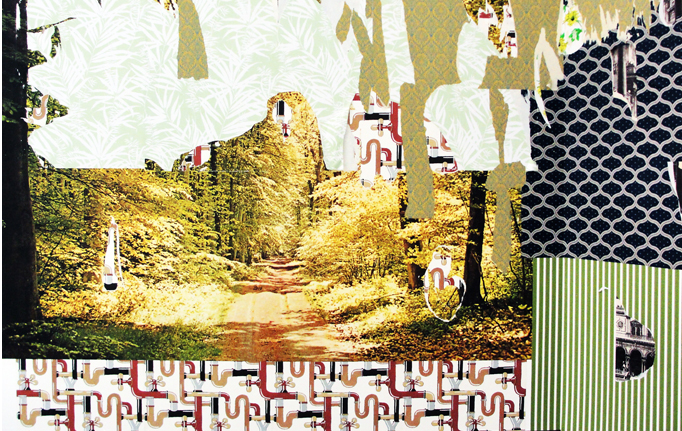
Muro O´Reverie, 2009 Pintura, fresco y diversas capas de empapelado
Fotografía: Anabella Reggiani
Alejandra Seeber, Argentine artist residing in New York, presents two works with a common discourse. On one hand, a wallpaper mural located in Gallery 5. Muro O´reverie, made specially for PROA, grasp, through Seeber´s gestures, the history, the memory, and the value of the image in order to reconstruct a period, a character, and way of observing the world.
The work Dialogville, 2009 consitsts by groups of dialogue bubbles distributes in several places around the Foundation´s space, meeting points, unfinished conversations, interrupted dialogues.
This works, made specially by the artist for Fundación PROA, demonstrate in a clear and sintetic manner Seeber´s artistic universe, linked to memory, the rediscovery of painting and the subjectivity of images throughout history.
The works
Muro O’Reverie, 2009
Paint, fresco and layers of wallpaper
In Muro O’Reverie, a wall unveils the memory of a room through by layering different wallpapers, frescos and paint, later teared by the artist. It suggests the passing of time in an architectural interior. It’s about constructed and fictional history of a room that had different purposes: as a child bedroom, a teenagers punk rock shelter, a school classroom, a store on sale, a dancehall, and a garage. The wall lets the imagination run through the events and the lives of those who lived there.
Connected directly with the mural painting tradition, Seeber uses industrial elements: the wallpapers to tell stories. Each wallpaper becomes someone’s presence and expects that through the industrial imagery available, time, moments and occupations can be recognized. Trough this method, the images become archeological symbols in a big city.
In a corner, a black hole cuts through the chromatic effect of the mural through an empty shredded wall, making the artists touch even clearer: disclosing, re-discovering, this metaphor of the black hole that rests next to the remains of a staircase, from a past rescue operation, with abstract lines imprinted on a perished building.
Dialogville, 2009 – 2010
Dialogue bubbles lacking works. The work is composed of transparent glass sculptures created by means of the free blowing technique that reminiscent of the comic language, but located, in this case, empty of text, phrases or conversations. The absence of words or a space open for multiple conversations? The artist focused on grouping this dialogues of group conversations in the spaces of circulation within the foundation: outside the exhibition galleries, on the auditorium entrance, corners of reason.
The bubbles located in this corners mark the space of a past dialogue: loving, political, violent, artists…? Also in this piece, Seeber demonstrates her artistic field for the reconstruction of history, time though symbols, vulgar and universal imagery on the global age.The artist
Alejandra Seeber, born in Buenos Aires in 1968. Lives and works in New York and Buenos Aires.
Took part in the young artists program leaded by Guillermo Kuitca in Fundación PROA (1994) and C.C Borges (1997).
Selected by the Atlantic Center for the Arts Residency Program (Florida) and developed a project for the Le Corbusier La Citè Radieuse building (2003) supported by Fundación Antorchas.
Has held solo exhibtions in: Hausler Contemporary (Zurich), Galería Fernando Pradilla (Madrid), Virgil de Voldere Gallery (New York), Sperone Westwater Gallery (New York), Galería Dabbah Torrejón (Buenos Aires), Parlour Projects (New York) y Alianza Francesa de Buenos Aires, among others.
Texts and Links
Victoria Noorthoorn
Introductory text for the S-Files show- September 2002
http://www.alejandraseeber.net/
http://www.lacan.com/perfume/seeber1.htm
http://www.virgilgallery.com/v2/?ikDirId=638
http://www.fundacaobienal.art.br/7bienalmercosul/pt-br/alejandra-seeber
http://www.revistaotraparte.com/artistas/alejandra-seeber
http://oneartworld.com/artists/A/Alejandra+Seeber.html
http://www.pagina12.com.ar/diario/suplementos/las12/13-651-2003-06-01.html
http://www.arte10.com/noticias/propuesta-415.html
Galleries 5 and 6
"Unseen voices"
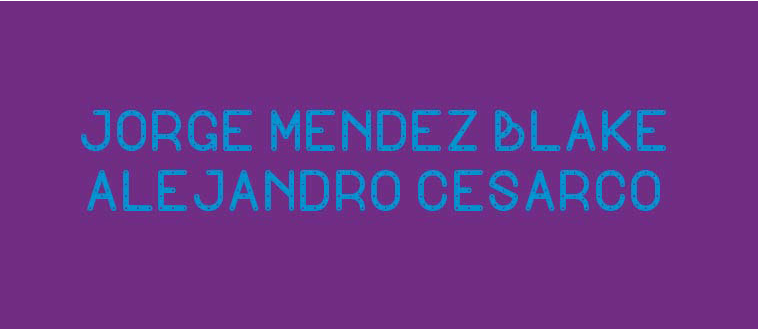
By Florencia Malbrán. Invited curator.
"Unseen voices" brings together work by two artists who turn to literature, as well as film and architecture, to reflect on the present and its links with the past. Alejandro Cesarco and Jorge Méndez Blake present the voices of Marguerite Duras and Jorge Luis Borges, among other authors. Their works are not limited to illustrating literature, or quoting written text, or making explicit the assumptions of their artistic practice. In these works, a very different dynamic between word and image is at play.
How to understand the present? How to access the here and now? We might answer that we need to know the past in order to explain the present and project ourselves into the future. We know, however, that history consists of thousands of facts that can be interpreted from thousands of points of view. We will never be able to reconstruct the full meaning of the past. This impossibility, far from leading us to surrender or relativism, merely renews the burning questions about our present. There must be a way of thinking and measuring time apart from chronometers and calendars, urges Jean-Luc Nancy, a key figure in contemporary culture. And Nancy commits himself to the “today,” seeking to give meaning to its fragments. The works exhibited in "Unseen Voices" engage in this search, proposing spaces that open time and allow us to explore the present, in a sort of interval, outside the furious succession of minutes into which the world plunges headlong.
When turning to the past, when reading it, these works make it present. They put on display voices that offer differences, new connections, without speaking uniformly or arriving to a definite resolution. Cesarco, Méndez Blake, Borges, Duras, Link: do they say the same thing? Or do they exhibit irreducible languages with specific and singular incumbencies? I would say that in these works there is no discourse, from one voice to the next, seeking to reach a conclusion. Instead, there is, once again according to Nancy, a “suspended step.” We cannot force from the juxtaposition of voices a higher meaning. Not even these works are fixed structures, nor are we monolithic spectators. It would seem the only thing permanent is change, as Cesarco once pointed out when explaining his artistic vision.
If the voices presented by Cesarco and Méndez Blake are in various states of agitation, it might be because they respond to a kind of restlessness manifested in the very space of these works. Both artists account for an implosion that occurred long ago, breaking the unique and singular artwork into many fragments, expanded throughout the exhibition space. Instead of beholding at a distance, we must now enter into these open zones: walk, read, view and explore their splinters, glimmers, shatters. Literature, then, would not be the only "other" in these works. These works embrace the "outside," are made of "other parts" that do not even seem to refer to art. The frame and the pedestal provided a type of support that is far gone ―as far as the certainty of interpretation. We must face this openness; we have no other choice than going through it, accompanying its elucidation. Inside these spaces, each of us can engage in dialogue, breaking or emphasizing words and whispers. Similarly, each of us can ponder about these spaces, imagine them anew, and, in so doing, transform the present.
The curatorial premise of "Unseen Voices" responds to Fundación Proa’s own architectural section, where the library is not only located alongside the exhibition galleries, but also is placed in the center of the building. In this way, tuned to current sensibility, Proa does not restrict culture into areas of competence, but opens to the complexity and intensity of contemporary experience.
Florencia Malbrán is an Independent curator. Master in Arts in Curatorial Studies from the Center for Curatorial Studies, Bard College (New York) and a Bachelor in Arts from the Universidad de Buenos Aires (University of Buenos Aires).
Conducted multiple critical and curatorial projects in different institutions and countries. In 2009, took a curatorial residence in ARTIUM, Centro Museo Vasco de Arte Contemporaneo (España). Integrated the curatorial department of the Guggenheim and worked at the Salomon R. Guggenheim Museum in New York, the Guggenheim Museum in Bilbao and the Peggy Guggenheim Collection in Venice. Also worked in the Museo de Arte Moderno de Buenos Aires and the Pinacoteca do Estado de São Paulo.
Published essays in specialized catalogues and contemporary art magazines. Received scholarships from the Consejo Nacional de Investigaciones Científicas y Técnicas (CONICET), the Fondo Nacional de las Artes and the Fundación Cisneros.For more information: prensa@proa.org / [+54 11] 4104-1044
Credits
Artists
Jorge Méndez Blake y Alejandro Cesarco
Invited Curator
Florencia Malbrán
Coordination:
Camila Jurado
Alejandro Cesarco
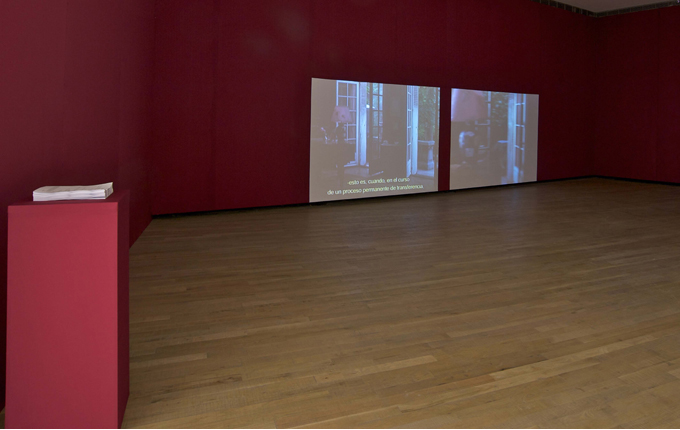
Alejandro Cesarco
Ellos, 2009-2010. Cortesía de los artistas
The artist Alejandro Cesarco presents two Works of his own: Marguerite Duras´ India Song, 2006 – during the “Otras Voces” exhibition – invited by Florencia Malbrán and Ellos, 2009-2010, with Ana Katz, in the Contemporary Space, invited by Cintia Mezza.
Marguerite Duras' India Song (2006), by Alejandro Cesarco, presents voices in transit. Two large screens show footage from the film India Song (1975), directed by Marguerite Duras and based on her eponymous play (1973). Cesarco made an edition in which the characters from the film disappear. The remains of their presence can be found in finely cut crystal glasses, a vase of roses, a piano, or the glittering strands of the chandelier. Both projections, displayed simultaneously, prevent the focusing of attention and begin to express how impossible it is to achieve that overarching meaning. The voices in the film disappear as well. They are replaced by a female voice-over, written by Cesarco, based on the literature of Duras and inspired by the "external voices" the author used. Duras broke with narrative conventions through these "external voices," which did not come from the characters in her stories nor correspond with the writer's omniscient pen. As such, they allowed imagining the most diverse sensations and memories. Despite these variations, the voice-over now presented by Cesarco does not come off as shrill, but is rather just as constant as the flow of information we receive when entering this space.
The voice tells a story of passion. It speaks of other invisible voices that narrate the story of two characters who “perform a dance of doomed love.” The environs of the mansion, as seen on the screens, seem to provide that passionate pastime with an ideal backdrop. And the red color chosen by Cesarco for the walls emphasizes the disturbances, the love, the drama. Daniel Link’s text, another component of the work, also helps build this strange atmosphere of desire. Two bodies, or two voices, watch the film India Song. According to Link they live two days of love, even though, in the oppressive heat, one of the voices tells the other it doesn’t want them to touch. Lying on a mattress, murmuring, they share thoughts on Duras’ film. One voice says "there must be a way to look at things," but the answer is just a pause.
"The air is so still and dense," reads Link’s text. Cesarco's work is indeed thick with voices. Large words fill the space: "feminism," "modernity," "colony," "literature," "film," "leprosy." Nothing could stir up the intoxicating, smothering atmosphere.
Contemporary Space
Alejandro Cesarco and Ana Katz
“Ellos” (They), 2009-2010
Situation for two characters, publication and performance
Courtesy of the artists
For Fundación Proa’s Contemporary Space, the artist thought of the direction of a performance conceptualized in collaboration with the Argentine cinematographer Ana Katz.
The visitor will be surprised by these seemingly risky dialogs that are nonetheless part of a script that will be available in the print edition.
The performers, in theirs roles as bookstore clerks, discuss “the possibility of understanding and transmitting the experience of the other,” and about “how the contemplation of the works exhibited in the institution influence the intellectual reflection of the spectator.” The spectator’s experience with this text could, or not, produce new meanings in the scene’s reception. The piece counts on the collaboration of the renowned actress, director and dramatist Ana Katz. In this manner, this situation brings a question to the mind of the visitor, just as it emphasizes the following phrase from the script: “Beauty continues to be a question.”
Alejandro Cesarco was born in Montevideo (Uruguay), in 1975. He lives and works in New York.
He has exhibited in Latin America, the United States, and Europe. Among his latest individual exhibition, some highlights are Two Films, Murray Guy, New York, 2009; 3 Works, Tanya Leighton, Berlin, 2009: Now & Then, Charles H. Scott Gallery, Vancouver, 2009; Once Within A Room, New Langston Arts, San Francisco, 2008; Retrospective, in collaboration with John Balderdash, Murray Guy, 2007; and Marguerite Duras’ India Song, Art in General, New York, 2006.
Alejandro Cesarco’s Statements
“Language is the most important cultural property that we have. We live, remember, talk, think, work, dream through language. We are immersed in language, we have inherited it, and we built our identity from it. Existence out of language is impossible. Thinking visual work from this viewpoint is a mode of abstraction. If I paint or photograph a red, the reference is that red, but if I write red, then there are infinite possible tonalities. I believe that my place as a cultural producer transits the limit, or the complicity, between reading and writing. My practice develops different methodologies, grammars, reading protocols. We are used to reading about art, yet we are much less used to reading as art. Reading is overall a visual act, every letter has a physical image, and every narrative has an image.”
“I’m interested in cataloguing, classifying, appropriating and reinterpreting ―and this relates to thinking about art as a great déjà vu. My work thus presents itself, at least formally, as a reformulation of historical conceptualism. Of course, difference is produced in such a repetition, and repeating does not necessarily mean a desire to go back to historic conceptualism. Translation and the notion of history, more precisely, the notion of translated history, is a recurrent motif and is explored through different narrative constructions.”
“I’m interested in the manner in which meaning is displaced, the manner in which discursive circumstances are recontextualized through memory, recognition and the opacity that is natural to language. Something I often repeat is that the strategic emphasis of my work is not placed on the transmission of information, but rather on the ways in which meaning is felt.”
Jacqueline Lacassa, “Alejandro Cesarco: El lenguaje es la propiedad cultural más importante que tenemos”, La República, Montevideo, 12 de abril de 2005.
You can get more information about the artist and his work at the following links:
http://murrayguy.com/current/index.html
http://www.tanyaleighton.com/index.php?pageId=116&l=en
http://onthemake.org/2009/10/22/alejandro-cesarco/
http://www.ecuad.ca/node/2875
http://www.ramona.org.ar/files/r42.pdf
Ana Katz was born in Buenos Aires in 1975. She studied at the University of Cinema, where she currently works as professor of Cinematographic Direction.
In 2002 she finished her first full length feature, El juego de la silla (The chair game), of which she was director, screenwriter, and actress. The film was recognized at the international film festivals of San Sebastián, Wurzburg, Lérida, Peñíscola and Toulouse, and by the Casa de América (Madrid).
The movie was then turned into a theater piece and was awarded by the San Martín Theater.
Katz also directed various shorts that were projected in a number of national and international festivals, and participated as an actress in the film Whisky, directed by the Uruguayans Pablo Stoll and Juan Pablo Rebella.
She is currently working on the cinema project Bienestar (Wellbeing) and the theatrical work Lucro cesante (Sacked wealth).
You can get more information about the artist and her works at the following links:
http://www.imdb.com/name/nm1195064/
http://www.cinenacional.com/personas/index.php?persona=13050
http://www.lanacion.com.ar/nota.asp?nota_id=844232
Texts
“Lo único permanente son los cambios”. By Jacqueline Lacassa
La República (Montevideo), 12/4/2005
http://www.larepublica.com.uy/cultura/172699-lo-unico-permanente-son-los-cambios
“Envios”. By Ana tiscornia, 2/2002
http://www.cesarco.info/textforenvios.htm
Jorge Méndez Blake
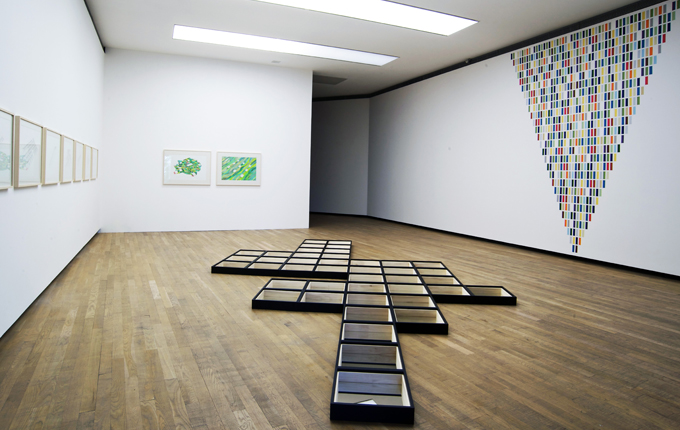
Jorge Méndez Blake
Estudio para biblioteca Borges 1. Cortesía del artista
The Borges Library, 2009-10, by Jorge Méndez Blake, is a continuation of the artist’s investigations on the voices that give meaning to the very concept of the "library." For Méndez Blake, the architectural appearance of the library, as well as its role as a book archival, should be indistinguishable from its cultural contours, its possibilities to generate and transform knowledge.
The library, precisely, is a fundamental topic in Borges’ literature. Méndez Blake explained, about the artwork he created especially for Proa, “the title The Borges Library came up while remembering the stories The Library of Babel and The Garden of Forking Paths, because my library is formed by a module that can be repeated infinitely and it also is a project meant to be located outdoors, creating a sort of labyrinth.” In the former tale, Borges proposes a library, in itself a universe, consisting of geometrically identical galleries repeated over and over, creating a maze despite their uniformity.
Méndez Blake exhibits, alongside a series of drawings and a mural, a model articulated in modules. He uses a tool typical of construction works to imagine a building whose logic exceeds that of traditional architecture. The modules create in the space a grid that has no center. Their clean, abstract appearance makes it so the shelves are not seen alongside the books. Each of the modules comes to compose, paradoxically, the entire library. These units, finite and discrete, enumerate, in their partiality, the infinite and the malleable. The grid could align well with the library proposed by Borges, which includes absolutely everything. His story is very clear: "Everything: the minutely detailed history of the future, the archangels’ autobiographies, the faithful catalogue of the Library, thousands and thousands of false catalogues, the demonstration of the fallacy of those catalogues, the demonstration of the fallacy of the true catalogue, the Gnostic gospel of Basilides, the commentary on that gospel, the commentary on the commentary on that gospel, the true story of your death, the translation of every book in all languages, the interpolations of every book in all books.” Méndez Blake could have been inspired by such an abyss for his library, which also presents voices battling each other, interruptions and additions and personal implications. While Borges' narrative voice speaks to "you," the reader (as the library is unfathomable, it knows about your death), Méndez Blake's work opens itself to “we,” the spectators. The mirror in each module multiplies the perspectives of the library but also gives us back our image, imploring us on.
The mural’s rectangles could be either the spines of the library books or the building blocks of their shelves. The colors are taken from the design of the covers of several editions of Borges books. In the library proposed by Borges, meaning slips away permanently. Even if books contain total knowledge, nobody can find any final answers in them. Méndez Blake exhibits this displacement. His work challenges orders and methods. It installs unseen voices in the library, in architecture, in art and in culture.
Jorge Mendez Blake’s Statements
“I’ve worked in the past with an extended concept of the library, in which it becomes a micro-system about a specific subject. These small systems, which include sculptures, drawings or models, have attempted to bring together different aspects of the topic in a open-ended arrangement and relationship, which creates new meanings and connections between things.”
“I think the idea of the library as the sacred storage of written culture has to evolve into an open democratic state, in which people interact and transform the way we organize and have access to culture and knowledge. We can no longer sustain the idea of culture as just one unique volume. The idea of the library as a sole institution has to move towards an ever-changing, constantly reshaped form. Just as literature cannot be seen as a homogeneous discipline, I think the “building” that contains it should be approached in a similar way.”
“I think objects are themes in and of in and of themselves. I’m interested in objects that go beyond their material nature. For example, it’s impossible to separate a book from its content. But if this book is placed in a different context and interacts with other elements in space, it begins to expand its definition and brings it into relation with the site. I’m interested in the way classic literature—as a popular cultural reference--can interact with everyday elements, such as buildings and urban space. In my work, architecture and literature create hybrids that stand in the middle ground between the disciplines.”
Jimena Acosta, “Interview with Jorge Méndez Blake”. August 5th, 2009.
Jorge Méndez Blake was born in Guadalajara (Mexico) in 1974. Lives and works in Guadalajara.In Mexico, exhibited in the Museo de Arte Moderno, Museo Tamayo, Museo Carrillo Gil, Museo Nacional de Arte, Fundación JUMEX, Sala de Arte Público Siqueiros, Museo MARCO and Museo Cabañas, among other spaces. In an international level, exhibited at the Maison Rouge, Museo Mac/Val and the Instituto de Mexico in Paris; the Zacheta National Gallery in Varsovia; Casa Encendida in Madrid; Instituto Paranaense de Arte in Curitiba, among other spaces. Conducted artistic residences in Spain, England, Italy and United States. His work intertwines literature and architecture to reflect on fiction, history, the constructed context, landscape and design. Explores the uses and shapes of the "Library", in its architectural construction and in the organization of knowledge. Other works investigating libraries include La biblioteca de la exploración, La biblioteca del paisaje, La biblioteca Muro and La biblioteca Romeo y Julieta.
Contemporary Space
Sintonías
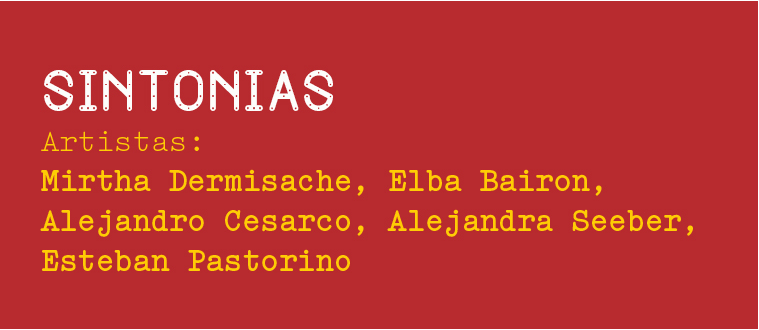
In the Contemporary Space we present Sintonías, coordinated by Cintia Mezza, with the artists Mirtha Dermisache, Elba Bairon, Alejandro Cesarco, Esteban Pastorino and Alejandra Seeber.
Esteban Pastorino is distinguished for the aerial shots he takes using cameras that he himself builds. For Proa’s terrace he has built two artifacts that evoke in their construction the instruments of mariners: a stereoscope and a periscope. These tools will enable the visitor to view the surrounding neighborhood of La Boca with optical alterations that vary the effect of reality.
Mirtha Dermisache’s works make some of the Fundación’s spaces their own. Tables, shelves and stands give the viewer/reader the opportunity to look at/read and to wander through the universe of graphisms the artist has been developing since the 1960s.
Artist Alejandro Cesarco and dramatist Ana Katz propose a performance that will surprise whoever visits the Bookstore, with dialogs among the clerks on the limitations of language.
Dialogs on dialogs on dialogs.
In the Cafeteria, Elba Bairon intervenes on the wall space with her sub-abstract figures: paintings, reliefs and cast sculptures that dialog amongst themselves in a scene that borders on the absurd.
Alejandra Seeber takes part in Sintonías through crystal bubbles made using a “free blowing” technique, making reference to the dialog bubbles from comics.
In this way, each artist offers pieces that both act as continuations of their previous works and make themselves part of the Fundación’s space, proposing a fresh view of the building.
Credits
Artists
Elba Bairon, Alejandro Cesarco, Mirtha Dermisache, Ana Katz, Esteban Pastorino, Alejandra Seeber
General Coordinator
Cintia Mezza
Organization
Aimé Iglesias Lukin and Programming Department
Sponsored by
Tenaris / Ternium
Mirtha Dermisache
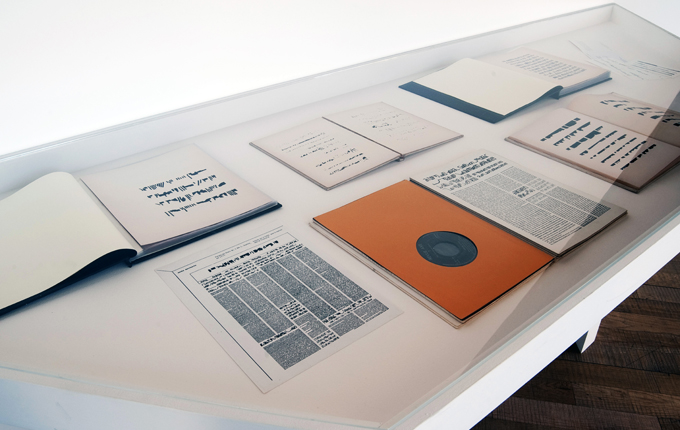
Diario Nº1, Año 1, 1972
Impresión offset sobre papel obra, 47,5 x 36,5 cm, 8 págs.
Cortesía de la artista
Beyond the written word. By Olga Martínez, invited curator
Within the framework of Sintonías, the works of Mirtha Dermisache make Fundación Proa’s space their own. Tables, shelves and stands will give the viewer/reader the opportunity to look at/read and travel the world of graphisms the artist has been developing since the sixties.
Dermisache's work is conceived of as a sort of writing. It was Roland Barthes who included her in the category of "illegible writings" and it was the artist herself who made clear "this does not mean anything." But that she does not want to say anything does not mean it ceases to be a work with full rights, in the words of Barthes. These same writings or graphisms are manifested in formats that are common in communication, including books, letters, articles, journals, postcards. This, apart from reinforcing the idea of writing, gives it some framework for readability. At the same time, in their materiality and in their expression through gestures, her works do not let us forget that their origin is in the field of visual arts, more so than any conceptualization.
In perfect agreement with the destination of her works, the artist adopted an approach of multiple diffusion, including the publication and its proper forms of circulation. For this fundamental reason, one of the accents in this intervention is placed on a publication as important as Diario Nº1, Año, 1972-1995, a work that had great impact on the world of graphics as well as displaying a strong political commitment. This piece, made available to the viewer/reader and put into dialogue with a selection of original works conceived before or simultaneously with this publication, will put on display the richness of the artist’s work, both as it pertains to the graphic world and in the variety of different formats in which it is etched.
Reinforcing the above, we return to this central point in Dermisache’s work: the multiple and her decision on how to make known the reproductions of her original works. It is important to point out something from the publishing criteria offered by the artist and jealously respected by those who have been her publishers: the work must not have any printed word, only a removable cover note without which there would be no reference to the author, publisher, or collection, thus achieving absolute autonomy. This is where the work takes on its full meaning, reaching a point where the publication displaces the original -manuscript- to begin its route through the channels of the publishing world. It is as such that in the Proa Bookstore the artist's recent publications will be sold, made available to the visitor to touch, read, and buy, and as such creating a space to link the publication and the viewer/reader.
This intervention also has two recent works from the series Public readings and Mural texts. The particularity of these works is evident in their format and purpose. It is no longer an intimate text that one must sit down to read, but rather something that demands to be looked at/read by the visitor from a very public space, despite the fact it will not impose itself with loudness, but with the subtlety of its ink and pencil tracings.
A curatorial text presides over the Bookstore, designed by the artist to initiate and encourage the public in this particular form of reading, that they may accept the challenge and let themselves be seduced by the journey of the tracings, finally to reach what Roland Barthes once called the pleasure of the text.
Olga Martínez
(1) Barthes, Roland (1989), "Variations on writing," in Campa, Richard, Writing and the etymology of the world, Buenos Aires, Sudamericana
Works
All works are courtesy of the artist
Diario Nº1, Año 1, 1972
Offset print on paper, 47.5 x 36.5 cm, 8 pp.
This work was made to be published by the Center for Art and Communication (or CAyC, in Spanish), directed by Jorge Glusberg, and displayed in the exhibition Art and Ideology CAyC in Open Air, within the framework of Art of Systems II. It was inaugurated in September 1972 and demolished by the police and municipality for its political content criticizing the government of Lanusse and alluding to the recent Trelew Tragedy (August 1972).
The artist’s creative process incorporates graphisms developed mostly in her books prior to the Diario, and includes a story that allows the intervention through writing of any viewer who is so disposed. Furthermore, there is a clear symbolic reference to the act of mourning represented by a black rectangle. Taking into account the cultural horizons of those politically agitated years, the symbol made explicit what had been happening just months prior to the completion of the exposition.
Guy Schraenen, its European publisher, also suggests a political reading of this and other works of illegible graphisms in times when society is silenced by coercion.
The piece has been published on five occasions: CAyC, 1972; Mirtha Dermisache, 1973; Guy Schraenen, 1975 (Antwerp); Artinf, 1974; Mirtha Dermisache, 1995.
Besides Diario Nº 1 , several other works are also presented: books, postcards, loose works, short stories, etc., which correspond to the development of different graphisms in this variety of formats of communication. The original work makes evident, among a number of details, the presence of color that from 1967 onwards was designed with the sole intention of avoiding a decorative interpretation of her work.
Mural text, 2009
Ink and pencil on paper, 70 x 100 cm
Public Reading No. 3, 2006
Ink on paper, 59.5 x 72.5 cm
The Public readings and Mural texts series are works begun by the artist in early 2005. The particularity of these works is evident in their format and purpose. It is no longer an intimate text that one must sit down to read, but rather something that demands to be looked at/read by the visitor from a very public space.
In the retail sector of the book store are available the publications of two of these works: Public Reading, 2005, and Public Reading No. 3, 2006, published by Florent Fajole (for Le clou dans le fer), Reims and Mirtha Dermisache, respectively.
Text, 2010
Cutting plotter on vinyl, 150 x 150 cm
A curatorial text in the Bookstore space intervenes in the institution itself with its graphisms, designed by the artist to encourage in the spectator this particular form of reading.
The piece was designed especially for this occasion in the traditional format of curatorial presentation texts.
The Artist
Mirtha Dermisache was born in Buenos Aires in 1940. She studied visual arts at the Manuel Belgrano and Prilidiano Pueyrredón National Schools of Fine Arts, respectively.
In 1967 she finished her first 500-page book, afterwards continuing with the development of her graphisms, which continues to this day. Her works were published between 1970 and 1978 by the Center for Art and Communication, led by Jorge Glusberg.
In the 70s her graphisms were published by Marc Dachy and Guy Schraenen in Antwerp and were also published in the magazines Flash art, Doc(k)s, Kontext, Ephemera and Ax. Additionally, Ulises Carrión exhibited her works in the gallery Other books and so (Amsterdam), and Roberto Altmann did the same in the Malmö Konsthall (Sweden). During this same time, she created the Workshop of Creative Actions in Buenos Aires.
Starting in 2004 and together with Florent Fajole, she carried out a series of publishing devices that explore the dimensions of the installation and the printing process, highlighting different conceptual aspects of publications in the same spatial reality.
Her first solo show in Buenos Aires was in the gallery The Edge. Later, she exhibited her work at the MACBA (Barcelona) and the Center Pompidou (Paris).
Texts and Links
Textos
El imperio de los signos. By Guillermo Saccomanno
Suplemento Radar, Página 12, 15/8/2004
http://www.pagina12.com.ar/diario/suplementos/radar/9-1604-2004-08-16.html
Poesía y signos de puntuación. By Belén Gache
Fin del Mundo. A raíz de la presentación del libro Perdón, imposible, de José Antonio Millán
Centro Cultural de España, 26/9/2005
http://www.findelmundo.com.ar/belengache/signos.htm
Tejidos esponjosos. By Arturo Carrera
Xul, n°3, diciembre, Buenos Aires
http://escholarship.bc.edu/cgi/viewcontent.cgi?article=1035&context=xul
Links
http://www.cceba.org.ar/db/artista.pl?id=369
http://www.labasicaonline.com.ar/Detalle.asp?Id_Espectaculo=4565
http://www.new-mag.com/authors/dermisache_mirtha.htm
http://flux.blogsome.com/2007/11/
http://cdla.info/fr/expositions/mirtha-dermisach-libros
http://escholarship.bc.edu/cgi/viewcontent.cgi?article=1035&context=xul
http://www.pagina12.com.ar/diario/suplementos/radar/9-1604-2004-08-16.html
http://www.findelmundo.com.ar/belengache/signos.htm
http://escholarship.bc.edu/cgi/viewcontent.cgi?article=1035&context=xul
Elba Bairon
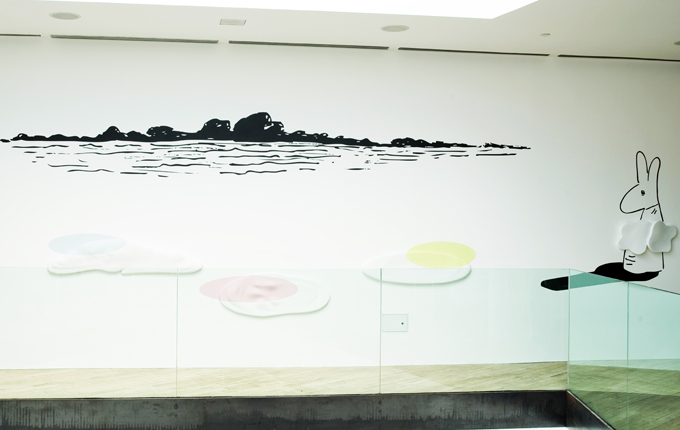
Sin título, 2009-2010
Instalación en la cafetería. Yeso, hierro, esmalte sintético y esténcil sobre pared. 2,7x7 m.
Cortesía de la artista
Since the early nineties Elba Bairon has been producing works that are characterized by a highly personal use of casting, paper, drawing and sculpture, resulting in pieces with a perfectionist finish. In this case, Bairon proposes for the Contemporary Space an installation composed of drawings, reliefs and objects. Various abstract figures dialogue with a character in a scene without clear explanation, typical of the absurd discourse that so often appeals to the artist in her works.
Dialogue and silence in the cafeteria, and like in Alice’s wonderland: time stands still, there is a rabbit , tempting food, and what appears to be the prelude to some unknown adventure.
Installation in the cafeteria. Casting, iron, synthetic enamel and stencil on wall.
2,7x7 m.
The Artist
Elba Bairon was born in La Paz, Bolivia in 1947. Since 1967 she has been living and working in Buenos Aires.
She studied engraving and lithography. In 1984 and 1987 she won the Foreign Award for Engravings at Buenos Aires’s prestigious Salón Nacional. In 1998 she was awarded a grant from the National Endowment for the Arts and in 2001 she received the Acquisition Prize at the Contemporary Art Biennial in Bahia Blanca.
Since the 1980s she has been participating in solo and group exhibitions in Buenos Aires at such establishments as the National Engraving Museum, the Salón Nacional and the Adriana Indik Gallery. She also exhibited at Intergrafik (Berlin), the Washington Printmakers Gallery, the Ninth Engraving Biennial in San Juan, Puerto Rico, and the Osaka Engraving Triennial, among others.
Texts and Links
Elba Bairon and the long dilemma of beauty. By Ana María Battistozzi. Clarín (newspaper), 24/5/2003
"Rigorous forms, though imperfect in their configuration, are displayed on the floor and on shelves, specially designed to contain and compensate for the instability that dominates them. It gives the impression that, if not for these devices, they would not be able to sustain themselves alone and would have long ago fallen, much like those fragments of archaeological remnants scattered on a table, or that out-sized female figurine collapsing in the middle of the room under the gaze of a baby chick.
(...)
Perhaps it is as Daniel Molina states in the catalog’s introductory text: that these latest ones are ideas that have taken form; the incarnation of pure objects in the sense that Plato gave them and, being so, exist somewhere out beyond the real world. As such, this exhibition can be viewed as a way to raise the ancient problem of the possibility of recognizing beauty. Or at least what it implies and has implied throughout the ages, and if this experience is still possible. "
Untitled
By Marta Dillon. Página 12 (newspaper), Supplemental section, 9/5/2003
"She is a rigorous woman who seeks constantly to strip away the unnecessary, both in her work and her life, by choice and necessity. Because her art is the reflection of a personal universe in which she lives, in this world and in these coordinates of time and space, she has not been able (or wanted) to take herself away from this period of loss and dispossession. On this occasion she sought the extreme simplicity of form, she took on a body, as she calls it, but a body referring to pure simplicity, 'without any popular sentiment,' trying only to be faithful to herself, to what was written on a piece of paper and which can be as simple as 'all opaque.' Instructions that could not be followed because afterwards they seemed lacking in sense, though the only thing that was truly brilliant in her exhibition was a 'black hole' that, according to the maker, was a cup of ice cream; for this writer, at least the trace of a lick, in its reflection, makes reference to the moisture of saliva.
Once upon a time, this woman of 55 years was moved by the rigor of technique. It was when she left the School of Fine Arts in Montevideo to study Chinese painting. She was amazed by its strict, rule-oriented world, acting as a container for those who had previously led wandering lives. At five years old she left her parents’ country, Bolivia, to seek refuge from political persecution. The family passed through Brazil and Argentina before having to disband to survive, and Elba was sent to live with an aunt in Uruguay. That's where the rigid limits of Chinese painting, almost a sort of calligraphy for her, taught her how chance and the will can combine to turn a traced line into a drawing. It was after this attachment to the norm that she traveled to Buenos Aires, studied engraving because she was still unable to let go of the security of technical support, and then dropped everything to devote herself to raising her children. Still, she never stopped drawing. ‘I cannot say if I won or lost the time I devoted to my children,’ says Elba with a mother’s modesty. What’s true is that she needed that quiet time to find her own language, to venture to work in volumes, and to find in these volumes the material with which she would build her private universe. "
http://www.galeriabm.com/english/muestras/0608_bairon.asp
http://www.boladenieve.org.ar/node/454
http://daisenberg.spaces.live.com/Blog/cns!1E24F43A0A268CCD!673.entry
http://www.macromuseo.org.ar/archivo/2007/10/elba_bairon.html
http://pandorama-art.blogspot.com/2006/11/elba-bairon-se-presenta-en-el-borde.html
http://www.clarin.com/diario/2003/05/24/s-05402.htm
http://www.pagina12.com.ar/diario/suplementos/las12/13-627-2003-05-12.html
Alejandro Cesarco

Alejandro Cesarco
Ellos, 2009-2010. Cortesía de los artistas
The artist Alejandro Cesarco presents two Works of his own: Marguerite Duras´ India Song, 2006 – during the “Otras Voces” exhibition – invited by Florencia Malbrán and Ellos, 2009-2010, with Ana Katz, in the Contemporary Space, invited by Cintia Mezza.
Marguerite Duras' India Song (2006), by Alejandro Cesarco, presents voices in transit. Two large screens show footage from the film India Song (1975), directed by Marguerite Duras and based on her eponymous play (1973). Cesarco made an edition in which the characters from the film disappear. The remains of their presence can be found in finely cut crystal glasses, a vase of roses, a piano, or the glittering strands of the chandelier. Both projections, displayed simultaneously, prevent the focusing of attention and begin to express how impossible it is to achieve that overarching meaning. The voices in the film disappear as well. They are replaced by a female voice-over, written by Cesarco, based on the literature of Duras and inspired by the "external voices" the author used. Duras broke with narrative conventions through these "external voices," which did not come from the characters in her stories nor correspond with the writer's omniscient pen. As such, they allowed imagining the most diverse sensations and memories. Despite these variations, the voice-over now presented by Cesarco does not come off as shrill, but is rather just as constant as the flow of information we receive when entering this space.
The voice tells a story of passion. It speaks of other invisible voices that narrate the story of two characters who “perform a dance of doomed love.” The environs of the mansion, as seen on the screens, seem to provide that passionate pastime with an ideal backdrop. And the red color chosen by Cesarco for the walls emphasizes the disturbances, the love, the drama. Daniel Link’s text, another component of the work, also helps build this strange atmosphere of desire. Two bodies, or two voices, watch the film India Song. According to Link they live two days of love, even though, in the oppressive heat, one of the voices tells the other it doesn’t want them to touch. Lying on a mattress, murmuring, they share thoughts on Duras’ film. One voice says "there must be a way to look at things," but the answer is just a pause.
"The air is so still and dense," reads Link’s text. Cesarco's work is indeed thick with voices. Large words fill the space: "feminism," "modernity," "colony," "literature," "film," "leprosy." Nothing could stir up the intoxicating, smothering atmosphere.
Contemporary Space
Alejandro Cesarco and Ana Katz
“Ellos” (They), 2009-2010
Situation for two characters, publication and performance
Courtesy of the artists
For Fundación Proa’s Contemporary Space, the artist thought of the direction of a performance conceptualized in collaboration with the Argentine cinematographer Ana Katz.
The visitor will be surprised by these seemingly risky dialogs that are nonetheless part of a script that will be available in the print edition.
The performers, in theirs roles as bookstore clerks, discuss “the possibility of understanding and transmitting the experience of the other,” and about “how the contemplation of the works exhibited in the institution influence the intellectual reflection of the spectator.” The spectator’s experience with this text could, or not, produce new meanings in the scene’s reception. The piece counts on the collaboration of the renowned actress, director and dramatist Ana Katz. In this manner, this situation brings a question to the mind of the visitor, just as it emphasizes the following phrase from the script: “Beauty continues to be a question.”
Alejandro Cesarco was born in Montevideo (Uruguay), in 1975. He lives and works in New York.
He has exhibited in Latin America, the United States, and Europe. Among his latest individual exhibition, some highlights are Two Films, Murray Guy, New York, 2009; 3 Works, Tanya Leighton, Berlin, 2009: Now & Then, Charles H. Scott Gallery, Vancouver, 2009; Once Within A Room, New Langston Arts, San Francisco, 2008; Retrospective, in collaboration with John Balderdash, Murray Guy, 2007; and Marguerite Duras’ India Song, Art in General, New York, 2006.
Alejandro Cesarco’s Statements
“Language is the most important cultural property that we have. We live, remember, talk, think, work, dream through language. We are immersed in language, we have inherited it, and we built our identity from it. Existence out of language is impossible. Thinking visual work from this viewpoint is a mode of abstraction. If I paint or photograph a red, the reference is that red, but if I write red, then there are infinite possible tonalities. I believe that my place as a cultural producer transits the limit, or the complicity, between reading and writing. My practice develops different methodologies, grammars, reading protocols. We are used to reading about art, yet we are much less used to reading as art. Reading is overall a visual act, every letter has a physical image, and every narrative has an image.”
“I’m interested in cataloguing, classifying, appropriating and reinterpreting ―and this relates to thinking about art as a great déjà vu. My work thus presents itself, at least formally, as a reformulation of historical conceptualism. Of course, difference is produced in such a repetition, and repeating does not necessarily mean a desire to go back to historic conceptualism. Translation and the notion of history, more precisely, the notion of translated history, is a recurrent motif and is explored through different narrative constructions.”
“I’m interested in the manner in which meaning is displaced, the manner in which discursive circumstances are recontextualized through memory, recognition and the opacity that is natural to language. Something I often repeat is that the strategic emphasis of my work is not placed on the transmission of information, but rather on the ways in which meaning is felt.”
Jacqueline Lacassa, “Alejandro Cesarco: El lenguaje es la propiedad cultural más importante que tenemos”, La República, Montevideo, 12 de abril de 2005.
You can get more information about the artist and his work at the following links:
http://murrayguy.com/current/index.html
http://www.tanyaleighton.com/index.php?pageId=116&l=en
http://onthemake.org/2009/10/22/alejandro-cesarco/
http://www.ecuad.ca/node/2875
http://www.ramona.org.ar/files/r42.pdf
Ana Katz was born in Buenos Aires in 1975. She studied at the University of Cinema, where she currently works as professor of Cinematographic Direction.
In 2002 she finished her first full length feature, El juego de la silla (The chair game), of which she was director, screenwriter, and actress. The film was recognized at the international film festivals of San Sebastián, Wurzburg, Lérida, Peñíscola and Toulouse, and by the Casa de América (Madrid).
The movie was then turned into a theater piece and was awarded by the San Martín Theater.
Katz also directed various shorts that were projected in a number of national and international festivals, and participated as an actress in the film Whisky, directed by the Uruguayans Pablo Stoll and Juan Pablo Rebella.
She is currently working on the cinema project Bienestar (Wellbeing) and the theatrical work Lucro cesante (Sacked wealth).
You can get more information about the artist and her works at the following links:
http://www.imdb.com/name/nm1195064/
http://www.cinenacional.com/personas/index.php?persona=13050
http://www.lanacion.com.ar/nota.asp?nota_id=844232
Texts
“Lo único permanente son los cambios”. By Jacqueline Lacassa
La República (Montevideo), 12/4/2005
http://www.larepublica.com.uy/cultura/172699-lo-unico-permanente-son-los-cambios
“Envios”. By Ana tiscornia, 2/2002
http://www.cesarco.info/textforenvios.htm
Esteban Pastorino
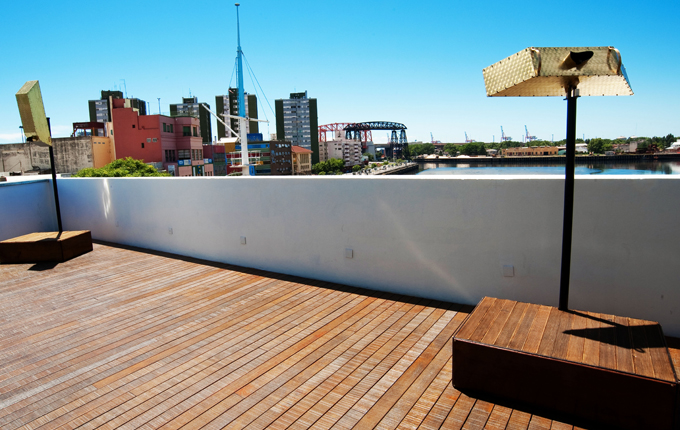
Estereoscopio, 2009
Latón, acero, madera y espejos
Cortesía del artista
Esteban Pastorino has developed an acclaimed career as a photographer, to which he adds research projects on the medium of photography, camera systems and visual effects.
On this occasion, he installs two visual devices on the terrace of Fundación Proa: a stereoscope and a periscope made of brass, both referring to marine artifacts.
These works change the landscape of the surrounding neighborhood of La Boca through a system of internal mirrors and lenses:
The stereoscope produces a three dimensional effect, while the periscope shows the landscape as if it were a miniature model.
The terrace thus becomes a viewpoint from the most representative corner in the neighborhood, establishing a dialogue between the institution and all that surrounds it.
An attempt, charged with at least some nostalgia, to symbolically reinstate the vantage point from La Boca’s old, now-defunct bridge
The Artist and his works
Stereoscope, 2009
Brass, steel, wood and mirrors
200 x 70 x 100 cm
Periscope, 2009
Brass, steel, wood, mirrors and lenses
240 x 70 x 100 cm
Esteban Pastorino was born in Buenos Aires in 1972.
He studied advertising photography at the Academy Fotodesign (Buenos Aires). He was later selected as artist-in-residence for the Photographic Center of Skopelos (Greece), the Rijksakademie Van Beeldende Kunsten (Netherlands), the Casa de Velázquez (Spain) and the Fiskars Artist Residency (Finland).
Over the course of his career he has received numerous distinctions, including the Leonardo Award for Photography (National Museum of Fine Arts) and the Abraham Haber Award for Photographer of the Year (Argentina Association of Art Critics).
In Buenos Aires, he has exhibited his works individually in ICI, the San Martín Theater Photo gallery, MAMBA, C.C. Rojas, and the Dabbah Torrejón Gallery. He has also exhibited his works in Belgium, Spain, the United Kingdom, France, USA, Holland and Mexico.
Texts and Links
Praise for the game. By Alejandro Castellote and Esteban Pastorino. Larivière Publishing
"In my opinion, what’s most striking about this collection of Esteban Pastorino’s photographs is not the subversion of reality, which he activates by intervening in the focal plane of the lens, but rather that this manipulation of a feature of a camera is capable, for example, of taking us back to childhood; it doesn’t just mutate the natural and urban landscapes into models, but is also capable of converting all the elements of the image into pieces of the universes we constructed in our childhood games. And to play in this way submerges us in a direct relationship with fantasy, with magic; it is a voluntary disconnection from rationality, an emancipation that allows man to interact with reality in a different way. And that ability coincides with one of the essential qualities of modern art, which separated itself in this manner from the classical theory of the Greek philosophers, who defined art as an imitation of reality. An idea that is in some way paralyzing, and which also affected the definition of the essence of photography since its invention, given the highly technical nature of its operations and the scientific and documentary applications ascribed to it in its early years. The advent of photography was one of the causes of painting’s crisis, as it achieved its classic goal with greater efficiency and less cost. But photography didn’t just contribute to painting’s crisis; it also facilitated its emancipation.
(...)
Esteban Pastorino’s visual paradoxes are the result of his fascination with building devices capable of provoking in the spectator an illusion of the senses. In a way, it develops a ritual with magical undertones linking it with photography’s passionate pioneers from the nineteenth century, particularly those that focused on the genesis of devices able to stop movement, extend the visual field or simulate three-dimensionality. Arthur Batut and Eadweard Muybridge are two referents of this group. Batut developed in 1890 a device capable of taking aerial photographs from a kite, which, thanks to the device’s versatility, widened the potential uses of the zenith shots that had already been obtained by Nadar in 1858 from a static hot air balloon. Muybridge became famous for his panoramas and his chronophotography, which broke down and froze the movement of people and animals. His research to simulate the animation of images led him to invent the zoopraxiscope, which many consider the precursor to the film projector. The nineteenth and early twentieth centuries were rich in experiments of this complexion, which often had great sounding boards in the Universal Exhibitions, where the audience watched, fascinated by these strangely-named inventions: zoetropes, phenakistoscopes, kinoras, kinetoscopes, folioscopes, dioramas or stereoscopic cameras and viewfinders. In some cases, these devices had scientific applications; in others it was simply entertaining to witness viewpoints or perceptions of reality that were otherwise inaccessible to the human eye."
Technical fiction. By John Valentini. PHOTO SPAIN 2008. Exhibition catalog
"Oftentimes photographers choose the camera according to the image they seek to obtain. What is distinctive, in Esteban’s case, is that he establishes the image’s ground playing rules, but it is not he, but rather his camera, who plays. Or, put another way, one of Esteban’s main tasks is to transform the camera (along with the developing and copy processes) into the imperceptible protagonist of the image.
His photos, then, turn on the problematic of photographic objectivity, but in the sense that they connect with the world, highlighting the technical elements of photography, or photography explored in its voluptuousness technicalities. This is also how the photographer "technifies" himself: ceasing to control, in large part, what is on the other side of the viewfinder, delegating that task to the internal laws of the apparatus. As if the photographer and camera were to strike up a conversation (in some cases even an argument). As if the photographer were to say to the camera: I’ll leave you alone (for example, off the coast of the Uruguayan resort town of Piriápolis, or mounted on a kite flying in Ciudad Universitaria in Buenos Aires), to see what you're capable of doing on your own. It is not, then, about objectivity as a sort of will to document, nor about a faith in the historical truth of the photographic object, but rather a distancing from the photographer's eye, a handing over of dominion to the material and the technical processes. It is, in short, a game of linguistics.
(...)
We, subjects constructed in a pervasively “technified” context, are continually amazed by the world produced by Esteban’s images. And not merely because we are attracted to the technical aspects. In fact, if the artifice in those images upsets our perception, it is because it breaks, or exceeds, the normality of constant innovations that technology itself brings to be. It is also, and at the same time, the key that opens doors to impossible worlds, and what stimulates in us an uncontrollable desire for fiction. Fiction, in this way, with a double meaning: it is what arises from the places created by technical forms unknown –or at least not experienced by us, and what we, as viewers, create over the base of that invention. We could call this confluence 'technical fiction'."
http://www.estebanpastorino.com.ar/
http://www.pdnbgallery.com/artists/esteban/
http://www.boladenieve.org.ar/node/472
http://www.photography-now.com/artists/K10104.html
http://www.cpw.org/exhibitions/2005/foreign_diaz/diaz/pages/gallery_diaz.html
http://blogs.lanacion.com.ar/merle/varios/esteban-pastorino-y-sus-camaras/
Alejandra Seeber

Muro O’Reverie, 2009
Pintura, fresco y diversas capas de empapelado
Fotografía:
Anabella Reggiani
Alejandra Seeber, Argentine artist residing in New York, presents two works with a common discourse. On one hand, a wallpaper mural located in Gallery 5. Muro O´reverie, made specially for PROA, grasp, through Seeber´s gestures, the history, the memory, and the value of the image in order to reconstruct a period, a character, and way of observing the world.
The work Dialogville, 2009 consitsts by groups of dialogue bubbles distributes in several places around the Foundation´s space, meeting points, unfinished conversations, interrupted dialogues.
This works, made specially by the artist for Fundación PROA, demonstrate in a clear and sintetic manner Seeber´s artistic universe, linked to memory, the rediscovery of painting and the subjectivity of images throughout history.
The works
Muro O’Reverie, 2009
Paint, fresco and layers of wallpaper
In Muro O’Reverie, a wall unveils the memory of a room through by layering different wallpapers, frescos and paint, later teared by the artist. It suggests the passing of time in an architectural interior. It’s about constructed and fictional history of a room that had different purposes: as a child bedroom, a teenagers punk rock shelter, a school classroom, a store on sale, a dancehall, and a garage. The wall lets the imagination run through the events and the lives of those who lived there.
Connected directly with the mural painting tradition, Seeber uses industrial elements: the wallpapers to tell stories. Each wallpaper becomes someone’s presence and expects that through the industrial imagery available, time, moments and occupations can be recognized. Trough this method, the images become archeological symbols in a big city.
In a corner, a black hole cuts through the chromatic effect of the mural through an empty shredded wall, making the artists touch even clearer: disclosing, re-discovering, this metaphor of the black hole that rests next to the remains of a staircase, from a past rescue operation, with abstract lines imprinted on a perished building.
Dialogville, 2009 – 2010
Dialogue bubbles lacking works. The work is composed of transparent glass sculptures created by means of the free blowing technique that reminiscent of the comic language, but located, in this case, empty of text, phrases or conversations. The absence of words or a space open for multiple conversations? The artist focused on grouping this dialogues of group conversations in the spaces of circulation within the foundation: outside the exhibition galleries, on the auditorium entrance, corners of reason.
The bubbles located in this corners mark the space of a past dialogue: loving, political, violent, artists…? Also in this piece, Seeber demonstrates her artistic field for the reconstruction of history, time though symbols, vulgar and universal imagery on the global age.The artist
Alejandra Seeber, born in Buenos Aires in 1968. Lives and works in New York and Buenos Aires.
Took part in the young artists program leaded by Guillermo Kuitca in Fundación PROA (1994) and C.C Borges (1997).
Selected by the Atlantic Center for the Arts Residency Program (Florida) and developed a project for the Le Corbusier La Citè Radieuse building (2003) supported by Fundación Antorchas.
Has held solo exhibtions in: Hausler Contemporary (Zurich), Galería Fernando Pradilla (Madrid), Virgil de Voldere Gallery (New York), Sperone Westwater Gallery (New York), Galería Dabbah Torrejón (Buenos Aires), Parlour Projects (New York) y Alianza Francesa de Buenos Aires, among others.
Texts and Links
Victoria Noorthoorn
Introductory text for the S-Files show- September 2002
http://www.alejandraseeber.net/
http://www.lacan.com/perfume/seeber1.htm
http://www.virgilgallery.com/v2/?ikDirId=638
http://www.fundacaobienal.art.br/7bienalmercosul/pt-br/alejandra-seeber
http://www.revistaotraparte.com/artistas/alejandra-seeber
http://oneartworld.com/artists/A/Alejandra+Seeber.html
http://www.pagina12.com.ar/diario/suplementos/las12/13-651-2003-06-01.html
http://www.arte10.com/noticias/propuesta-415.html